The candidates of this comparison Zeiss Touit 32mm f1.8, 7Artisans 35mm f1.2, 7Artisans 35mm f0.95.
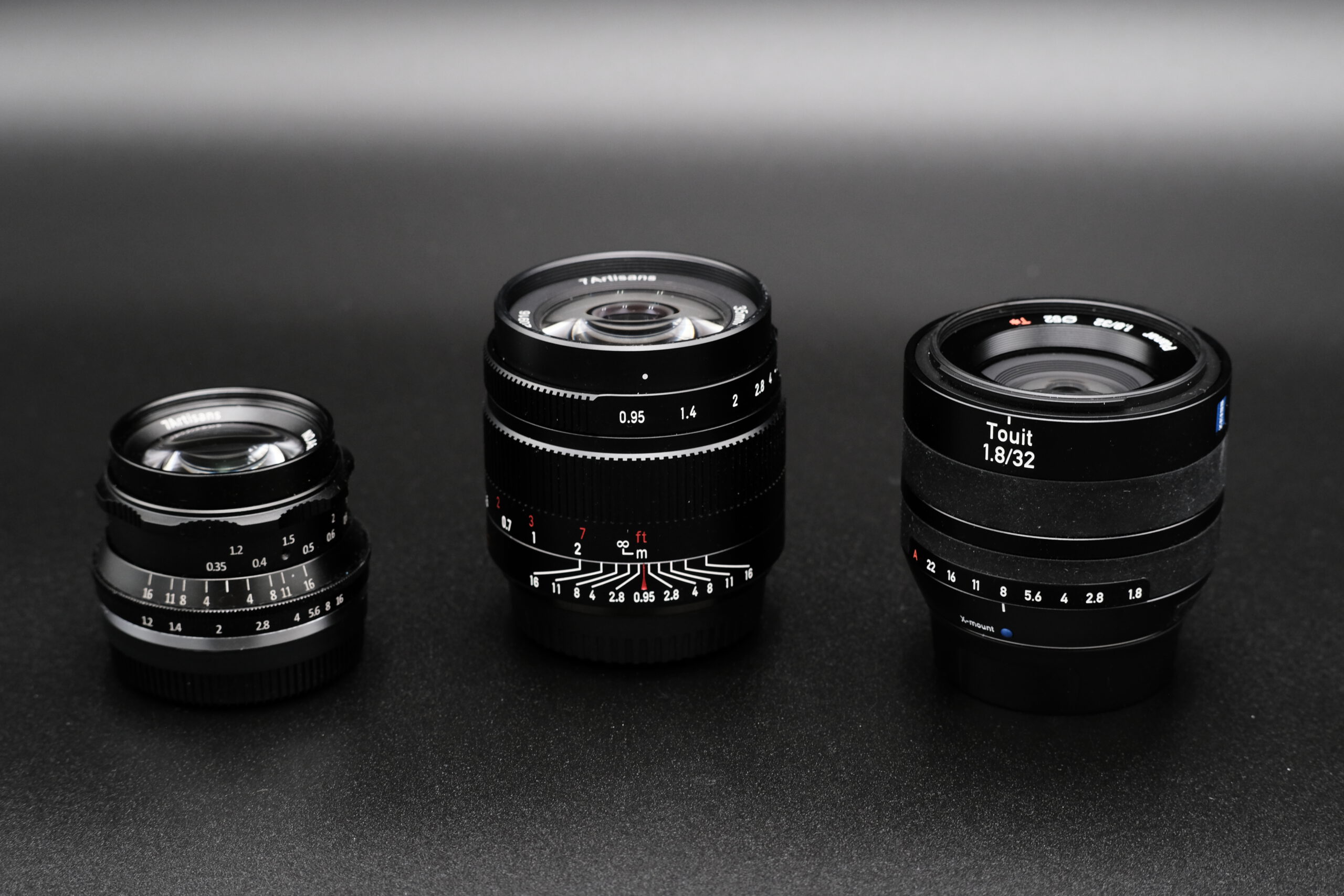
Since my early days, when I was 15 years old and got my first camera, my favored lens to take pictures in almost all situations was a 50mm lens (35mm on APSC). An image does not get composed on the negative film or today on the digital image sensor but in your mind. You see a scene, a situation or just a person and your brain starts forming a composition you would like to see later as a valued memory printed on high grade photo paper. What does this all have to do with a 50mm lens? As we all know the 50mm on a 35mm film or sensor format has the sight experience of a human. That´s why, in forming the virtual composition in mind that lens is just perfect for me in many situations. It´s even a zoom if you got your Nike´s on. Long story made short, a 50mm (35mm APSC) lens is my mostly loved tool. I can survive a 4-week trip in America or in Japan just with such a lens on my camera and I will get a rich collection of many very different images.
After a long journey, being a Nikon addicted user for many years, I finally found my home at the Fujifilm X range of mirrorless cameras and APSC sensor. Being even more precise, I have chosen the Fujifilm X-PRO2 as my favored tool. It has been like coming home after this long journey to find the perfect camera. But this is a long story I might tell you in detail in another report later in time.
That all has been my high motivation to compare a group of Third-Party lenses from 35mm to 32mm lenses for Fujifilm FX mount. The candidates in this comparison are, except to the focal length, very different and might target also different groups of photographers.
Just to avoid misunderstanding: “This is not a sponsored test. I have bought all the lenses by myself.” As well, I do not run lab tests on the lenses and measure the glass to it´s last digits of performance but I use my long year experience in photography and compare the lenses based on an image, taken under the same condition and at the lenses sweet spot. To me, photography is so much more than black and white physics and pixel counting, it is emotions and character. Pointing out all this, it is now clear that my result of this comparison is less objective but subjective. The good thing is, I share those high-res pictures with you, so you can make up your own mind and you can agree or simply disagree.
Short intro to the candidates for this comparison
The premium Zeiss Touit 32mm f1.8 lens got electronic coupling with the camera and is exchanging data of focal length, chosen aperture and focusing distance. As well this lens is offering auto focus functionality and in manual mode it is focusing by wire. To be complete, focus by wire means, by turning the focus ring there is no mechanical mechanism shifting the internal lens setup but the autofocus motor gets impulses to shift the lenses electrically. This is a technology that is getting more and more common in the industry and at many brands. There are some bad examples around where there is a lot of delay between turning the focus ring and the adjustment of the lens. But in case of the Zeiss Touit I can confirm that the response is in real-time and for most use cases it is more than sufficient.
Part of this very good user experience is coming from the outstanding rubber touch surface of the focus as well aperture ring which is fun to use with a very good grip. The downside of the rubber coating is that it is difficult to clean, and you always have some dust sticking to it.
The over all build quality is very high but still compact as you of course expect from a APSC lens. “One of the things that attracts me to APSC cameras and lenses is their very small and lightweight footprint. It is always on the man also during my global business trips.”
The body of the lens is made out of a mix of high-end polymer and metal. The bayonet connection is made out of shiny coated metal, perfectly connecting with a tight fit to the camera body. All this signals you that you got a high-end premium lens in your hands.
Next to the high build quality of Zeiss lenses the one thing that makes them world famous and allows them to ask a budget unfriendly price is their optical glass. Zeiss glass is rendering colors slightly colder than most other brands. It might be this in combination with the very high resolution of this glass that offers the “cutting edge more” producing an atmosphere of plasticity in the picture, of a kind off three-dimensional effect. The image is catching you and an impressive space is produced in an 2D picture and that even with “just” a maximum opening of f1.8.
There are some lenses out there that just do everything right, sharp from corner to corner even wide open, high resolution with many details but at the end their pictures are just “nice” or in other words they are boring if not many “Photoshop Artists” would push the pictures to their limits. With a lens like the Zeiss Touit 32mm f1.8 this is not needed at all. This lens has an absolutely unique character you will love or hate. I am in love with it. The character of this lens supports my style of taking pictures, “straight out of the camera” just based on one of the brilliant Film emulations provided by the Fujifilm X camaras.
The other two candidates at this comparison are designed and built by 7Artisans, a young Chinese lens and adaptor manufacturer.
“7Artisans is a group of Chinese camera enthusiasts who came together for a dinner in Summer of 2015. They discussed their passions over the dinner table. Some were interested in optical design while others were more skilled at running factory production lines and one was an avid Leica lens collector. Everyone who participated came to same conclusion: “If we involve our skills and work together, we can create new high quality original camera lenses.” That is how the 7Artisans Project began. “ 7Artisans on the web
The first lens from 7Artisans in this comparison is the 35mm f1.2 MK 1. This lens is ultra-compact and in combination with a vented hood, a retro style beauty with every rangefinder type of camera, as my loved Fujifilm X-PRO2. Why Retro style? The focus ring of this small 7Artisans lens remembers me so much to my “old” 1968 Nikkor 50mm f1.4 F mount lenses on my Nikon F Photomic body. This combination I always loved to use, even once or twice a year in 2021. As well they share the high-quality full metal build quality.
In a direct comparison, the Zeiss Touit lens, which is with no doubt, as mentioned before, a well build premium product feels a bit plastic. This impression emphasizes if you have both lenses at the time in your two hands. It might be the more on weight compared to the size of the 7Artisans or the rubberized focus ring on the Zeiss Touit supporting this personal felling.
The 7Artisans 35mm f1.2 is as all the 7Artisans lenses fully manual. No autofocus motor or any information coupling between the lens and the camera body. As in the old times, this is just the charm of the lens and the fun to use them even today every day. I call this “back to the roots of photography”, slowdown, breath, create the imagination of the picture in your mind. You decide for the focal depth in your image and place the focus on the object you want to highlight by turning the wonderful smooth moving but also well damped focus ring on this 7Artisans lens. A mechanical precision that outperforms all AF lenses, even those with the highest technology offered today, focus by wire systems which are featuring high resolution stepper or even ultrasonic torque motors.
If you have never tried a well-built manual lens, try it but with the risk that you get addicted to it and will have troubles to still love your “high tech” lenses. Please do not tell me afterwards that I did not warn you.
The third candidate in our trio for the lens comparison is the 7Artisans 35mm f0.95. Yes, this is not a typo it is a f0.95 lens, something I have always been dreaming of. A lens perfect for low light portrait pictures of a pianist in a dark and smokey Jazz Bar, close to the river. A lens that even can capture sharp and with high-res details street photos in the late evening as the ISO does not climb sky high. You can freeze in fast-moving people that might be heading home to get to their families. I remember, about 30 years ago I tried the Nikon Nikkor Ai 50mm f1.2 lens, the most wide-open Nikon lens at that time. I returned it after 3 days back to the shop as this lens has been that “soft” at f1.2 that I considered it as being useless at that time. To be honest, with that many years of distance I am not sure today if it has been the quality of the lens or me being unable to focus well wide-open. Today, the new state of the art mirrorless digital bodies are having outstanding manual focus support tools that even focusing the 7Artisan 35mm f0.95 is easy and very convenient.
Of course, as all lenses on the market, the highest resolution/sharpness also on this lens you will find at a range of f4.0 to f5.6. Due to this I decided to perform the comparison of the three lenses at this sweet spot of f5.6. If you want pixel peeping results at all f stops of these lenses, you find to each of the lenses enough high technical tests/reviews on the net.
The build quality of this f0.95 lens is stunning. Metal all over, a graphite color anodized metal bayonet connection and a smooth but very well damped running focus and aperture ring. A challenge to me has been that on this 7Artisans lens the position of both rings are changed compared to my other Fujinon and some 7Artisans lenses. I always was used to have the aperture control close to the body and at the far end of the lens adjusting the focus. I won´t believe how often I changed the aperture instead of focusing my image… Finally, after I opened my mind and practiced a lot, I got the change managed. Today I would even say this is even better to me as the other way around. You choose an f stop once for a picture, but you are constantly adjusting the focal plane in your image. Having the focus close to your body makes things much easier and quicker.
“This even proofed that an old dog can still learn new tricks.”
Of course, the rich use of metal and glass has its weight. The Zeiss Touit 32mm f1.8 adds 210g to your camera, the 7Artisans 35mm f1.2 the light weight in our comparison only 150g and the available light monster the 7Artisans 35mm f0.95 adds 369g. This is more than double compared to the 7Artisans 35mm f1.2 but on a Fujifilm X-Pro2, that body has a weight of 495g ready to use, it is a kind of well balanced and offers to my big hands a good stabilization for wide-open, slow pictures just out of the hand. With a strong and good stand and keeping my breath, photos at a shutter speed of 1/10 are wonderful sharp to the spot.
If you use the 7Artisans 35mm f0.95 on a typical pocket size camera as the great new Fujifilm X-E4 which has an operational weight of only 364g, the 150g 7Artisans 35mm f1.2 with its very compact size will be a better match for an always to go combination.
If lightweight is your first priority on your trip, my tip is to try out is the new 7Artisans 18mm f6.3 UFO lens. Even so, also full metal build, this tiny lens only weights 49g and is flat as a classical bayonet cap. Nevertheless, the picture quality is for street photography very well with a wonderful and rich color rendering. I am wondering why some people name it a toy or fun lens.
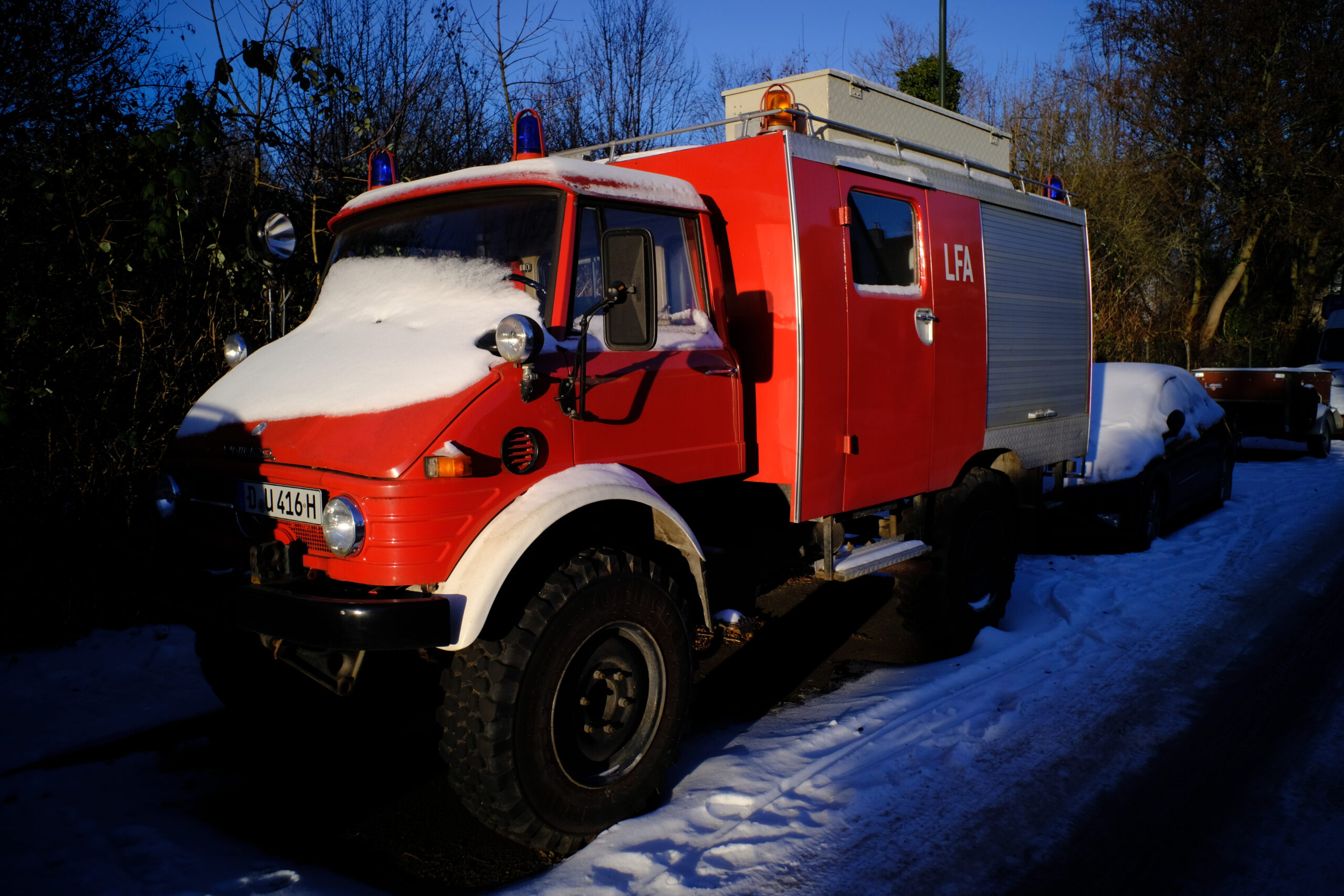
Sorry for being drifting off the topic of our comparison but you can now imagine my passion for the subject photography that has motivated me to run this project.
Let´s face reality
To perform these and future tests, I have installed a tabletop setup that just fits in to my light tent for perfect light conditions. I used for endurance and repeatability a metal plate to install the different components. My foundation is a high-resolution lens test chart that I have been cutting into pieces to enlarge the surface of my test setup. Around and in between these test charts I added three dimensional objects with a rich level of details and fine textures, that allows to compare, just by eye, the performance of the different lenses.
You can find a collection of feathers as well shells and river washed stones. Some small bottles of the famous liqueur Killepitsch from Düsseldorf, my hometown, where I was born more than five decades ago.
All this rounded up with some international coins, an old but fancy key and a copy of the declaration of the Communism Party written by Marx and Engels. I bought this book in 1979 when I visited the GDR and was forced to change some money to enter the county. As at this time there was not much you could buy in the GDR, I finally spent the money on some books in a State Book Store. The result of this shopping trip I have now glued to my test setup.
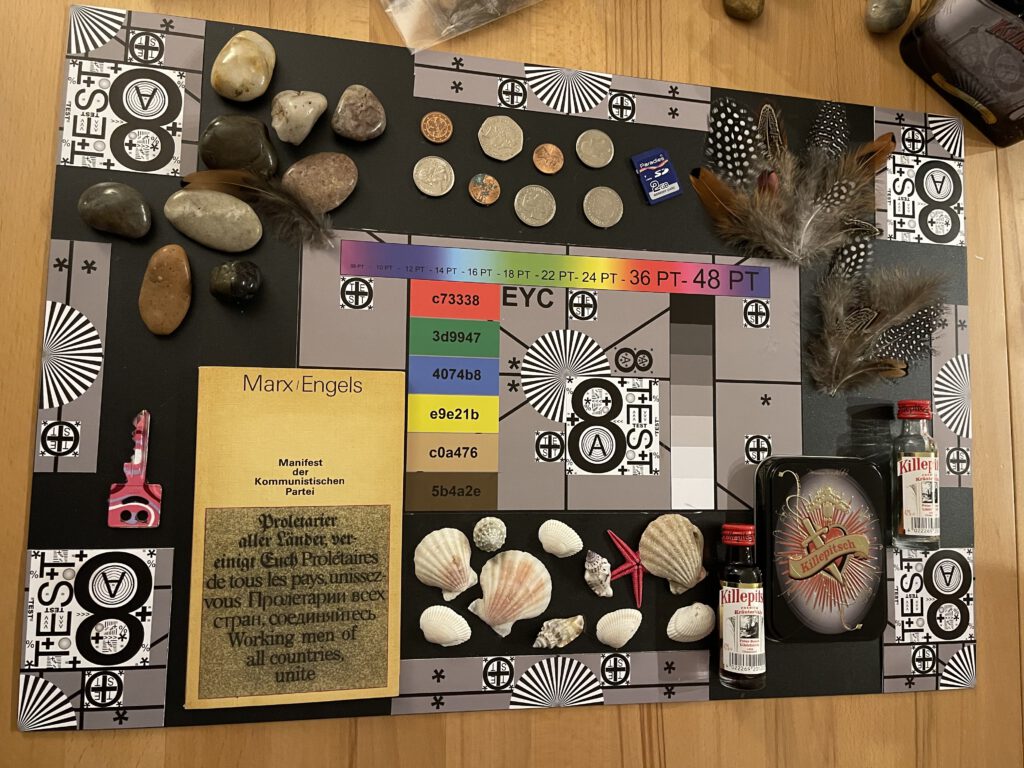
To perform a comparison that allows an honest judgement, I used the uncompressed 24-megapixel RAW files with an around of 50 Mb file size out of the Fujifilm X-PRO2 and converted them to JEPG without any white balance, sharpening, automatic (Zeiss Touit) lens or any other correction. As mentioned before, to further perform this analysis in a neutral environment I took the pictures at the sweet spot of all three lenses at f5.6.
Zeiss Touit 32mm, f1.8
The first thing, that snaps into my and all our eyes is the cool green rendering of colors of this lens. I believe that this cool appearance is part of the effect that creates the before described three-dimensional effect, I often see and highly value, in the pictures taken with the Zeiss Touit lens.
A second thing we notice immediately, is the strong optical distortion of the image. If this picture would be a JPEG, generated directly in the Fujifilm X-PRO2, we would not see any distortion as this will be corrected automatically by the in Camara processing. The same would happen if I would have used automatic lens correction in the RAW image processing. Fact is, that many modern high-end first brand lenses have very little optical correction as this often has an impact on the image resolution produced on the Sensor. It is a balance between just enough optical correction and software correction in the camera or during desktop image process with the right correction profiles, to achieve in sum the best possible image quality and resolution. In the case of the Zeiss Touit 32mm f1.8 this has been very successful. The optical resolution at the center is very high as expected for such a lens. To the corners the resolution is degrading slowly but stays over all in a good range. All this of course, at an aperture of f5.6.
The vignetting at the corners is minimal at f5.6 there will be another story told, as with most lenses if you perform wide open pictures. Of course, if you use those lenses wide open, you have to accept those variations. They are the price you have to pay for the huge benefit of extra light and wonderful bokeh you get wide open that emphasize the object in the focus of your image.
Impressive are the small details for example of the feathers or resolution in the texture of the shells. The Zeiss Touit lens proofs again, to my opinion, how three dimensional some of the objects appear on this in reality two-dimensional picture. For example, the metal cover of the Killepitsch box seems to stick out and I almost want to grab and touch it. The same effect I can see on the ball pen with its shiny metal dots on the housing.
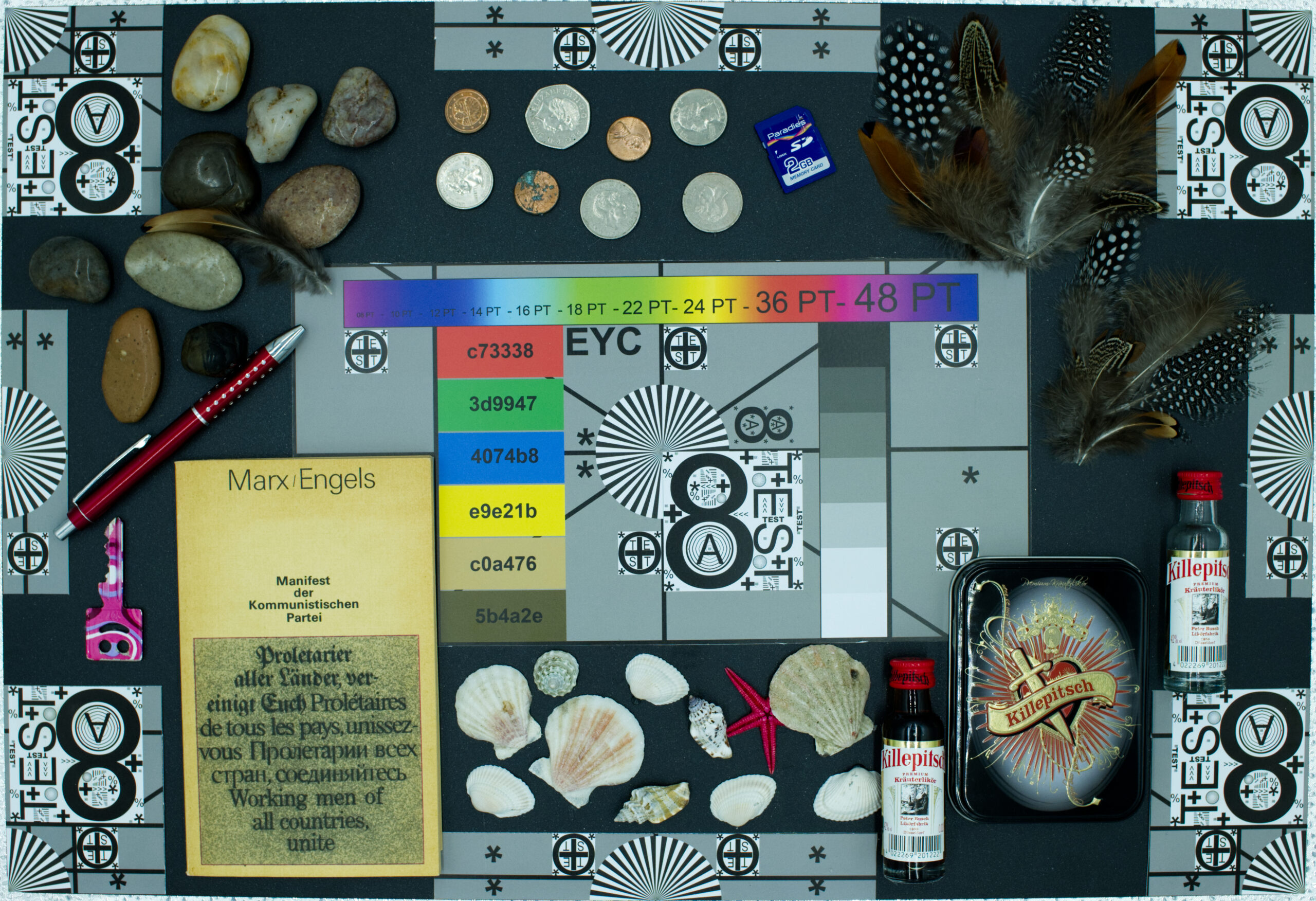
7Artisans 35mm f1.2
The 7Artisans 35 f1.2, the smallest and lightweight lens in our comparison is showing a sharp center image with a high resolution. Around the center, sharpness and resolution is only average and at the corners it´s poor. To my understanding this is a result to the compact and simple optical system (5 groups 6 elements) used for this lens. A trade in for the smallness of this always in your bag lens.
After studying the Zeiss Touit image in detail for a while I noticed immediately the difference in color rendering of this lens. To my opinion, without any corrections the image is close to neutral, if you really search minimal trends, it is going into the red direction. To me a well reproduced white balance of the reel image as I see it with my two eyes.
If I compare the IQ of the Zeiss Touit with this little 7Artisans lens, there is no doubt the winner in all categories is the Zeiss lens, with one exception, the high optical distortion is equal. The advantage of the Zeiss lens is the electronical coupling between lens and camera and based on the electronical type plate, the Fujifilm Cameras will correct this distortion with software correction when calculating a jpeg out of the RAW data. If you need the same correction for the 7Artisans 35mm f1.2 lens, you will need to do create manually a correction profile in the post process on your computer in one of the Image Software´s (e.g., Photoshop, Lightroom, Capture One or Affinity Photo…).
Overall, and this is my absolute personal taste and impression, I like the small and retro looking 7Artisans 35mm f1.2 lens very much. Small during traveling and if you focus on having the key element of your image in the center, as you tend to do in Street Photography or taking images of human, you will have great images with tons of character.
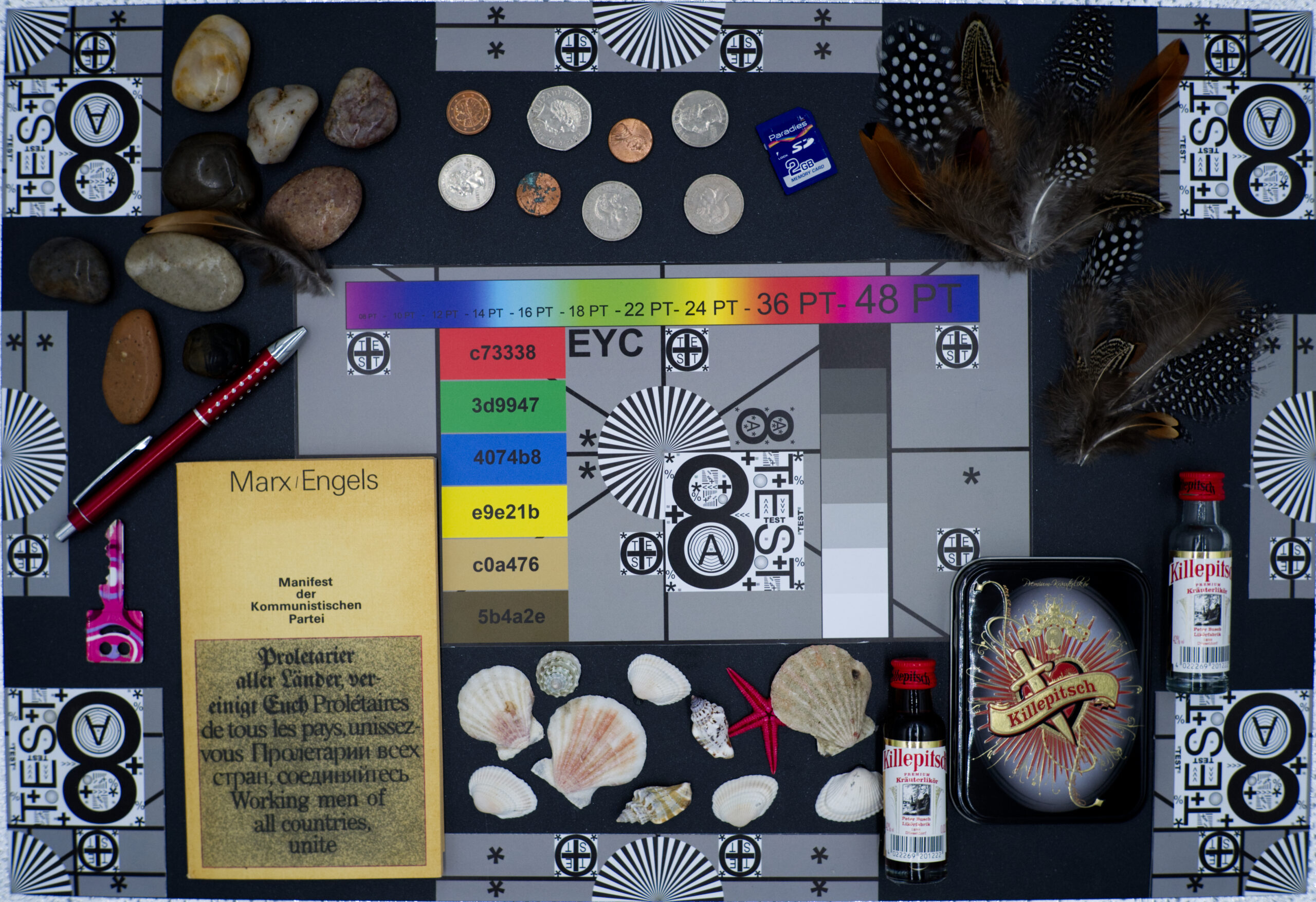
7Artisans just released a brand-new MK 2 version of this lens, the 7Artisans 35mm f1.2 MK II. It looks a little less retro, has the same small footprint and lightweight but has got a different optical setup. As well 10 in place of 9 aperture blades for even more creamy bokeh. The minimum aperture added one stop from f16 to f22. The closest distance moved from 35cm to 28cm, measured from the sensor surface. I might soon buy this new lens and would love to compare it, to learn how much more IQ the new lens has compared to my first version.
7Artisans 35mm f0.95
The biggest and heaviest lens in this comparison, the 7Artisans 35mm f0.95, is offering a lot of reserve during available light photography. Even if I repeat my self in this “fight of the lenses”, this is not important. The image I used to compare the lenses is made at f5.6. To me this is the typical used opening, during my nature and street photography. Sharpness and resolution are what I expected to be, at the maximum, at this setting.
This is the big difference between the 35mm lenses from 7Artisans. Was the 35mm f1.2 only really sharp, with a high resolution, in the center the 35mm f0.95 is offering this IQ at all points of the image. From the center to the corners sharpness and resolution are offering a high quality.
As on the Zeiss lens, I love to look to the rich details of the feathers, the reflective tiny markings on the coins and the nearly 3-dimensional rendering of the Killepitsch bottles including the details in the labels. Don´t you have the same impression as if you can grab the stones at the left corner? The battle is open between the grand dame in optics Zeiss and the aggressively priced newcomer from 7Artisans. I must confess that the two 7Artisans have one thing in common, the neutral color rendering.
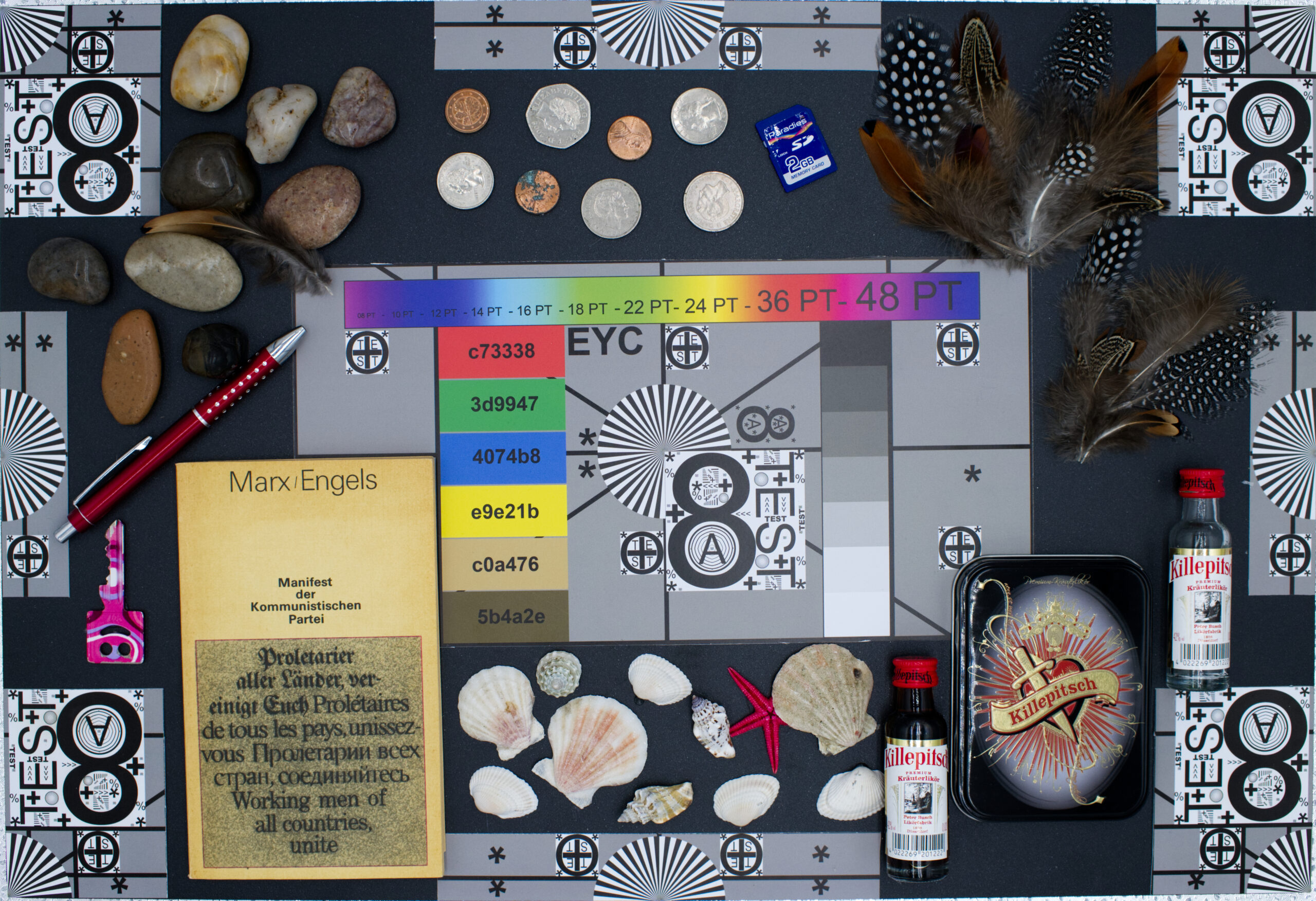
A neutral color rendering supports my typical approach of using, sharing and posting of “Straight out of the camera” pictures. Of course, you can correct the color touch of the Zeiss lens, but this is an extra effort in a post process. I am also very positive surprised in the optical correction of this lens. The distortion is minimal, and I am sure a correction is in 98% of the cases not needed at all. 7Artisans has heavily invested in great glass at this lens.
Verdict
And the winner is…
To make it that simple is almost impossible for me. Yes, the 7Artisans 35mm f1.2 has the lowest overall IQ. But please remember, this lens can be bought for just 139$. Much more important is the lightweight and small footprint of this lens and the fun I always had using it. I can spend days on a trip and use only this lens. Compose my pictures, choose the right field of depth and even have enough reserve in many low light situations. It is a lens with character you can fall in love with. This is my winner in the category travel lens.
To decide between the Zeiss Touit 32mm f1.8 and 7Artisans 35mm f0.95 lens is even more difficult. To my opinion, the 7Artisans has a better optical quality. Not only the optical distortions are better corrected but also resolution and image details are to my impression a little bit ahead of the Zeiss Touit lens. To be honest, this is complaining on a very high level as the images of both lenses will please you in most photographical projects.
Perhaps I can describe it that way, the 7Artisans 35mm f0.95 is my first choice in any low light situation, knowing that even at full bright light the image quality is very high. The advantage of the low light you pay with more weight but as described before it is balancing wonderful on the solid X-PRO range of cameras. Compared to the Fujinon 50mm f1.0 WR it is still small and lightweight.
The Zeiss Touit 32mm f1.8 is a great bridge on level of image quality, weight, size and offers even decent auto focus. As explained before it is a high-tech lens from one of the most famous brands in the world of photography. Of course, all this has its price but recently you can buy it new for much less as what it was, when the lens was released in 2013.
My final ranking
| Rank | Lens | Specialty |
| 1. | 7Artisans 35mm f0.95 | Master of low light photography and resolution |
| 2. | Zeiss Touit 32mm f1.8 | Universal lens with Autofocus |
| 3. | 7Artisans 35mm f1.2 | Lightweight and budget friendly travel lens |
All three lenses got their reason to be on the market and in my photo backpack. Read my findings and opinion, look to my pictures and make up your own mind.
I wish to all of you: “Always enough light”
Sunday, 16. May 2021, ©Malte Schlüter
Like it, can feel your passion
Nice review, even though your personal bias is showing :). No insult meant, as we all have those, and I share some of yours. Particularly with small manual focus lenses. Not, however, the reason I’m writing. The 50mm lens is a slight telephoto when compared to the human eye, which has a focal length of 43.5mm. Since you have a Fuji X (as do I) try the 27/2.8, which gives a focal length of 40mm. Or borrow a Pentax 43 mm. You’ll notice the difference immediately, as the 40-45mm range gives the same perspective as the eye. That said, I carried a 50mm lens for 50 years. The slight telephoto crops the image a bit and I suspect that’s why it’s been so popular, especially in the film era when cropping was much more time-consuming. Today, I’m considering ordering a 40 or 45mm lens for my full-frame Sony, even though I have Zeiss C/Y 50 and 35 already. Cheers, and pursue your personal preferences by all means. 🙂
Thanks Bruce für your kind words.
I have the Fujinon XF 27mm f2.8 in my photo bag as well the 7Artisans 25mm f1.8. You are right, it’s even closer to the human eye. It‘s seems that this little bit telephoto effect on the 35(50)mm that compresses slightly the room is attracting me.
Please come back and read my next 50mm lens comparison. Candidates will be the Fujinon 50mm f2.0 WR, Fujinon 56mm f1.2, TTArtisan 50mm f1.2 and finally 7Artisans 55mm f1.4 MK II.
Hello there! This article couldn’t be written any better!
Looking through this post reminds me of my previous roommate!
He constantly kept talking about this. I am going
to send this information to him. Pretty sure he’s going to have a great read.
Many thanks for sharing!
Best view i have ever seen !
What’s uр friends, gߋod pіece of writing and I am in fact enjoying by these.